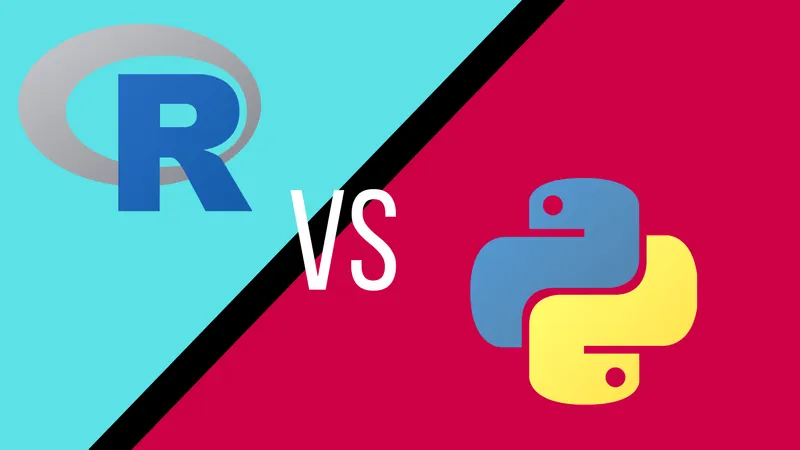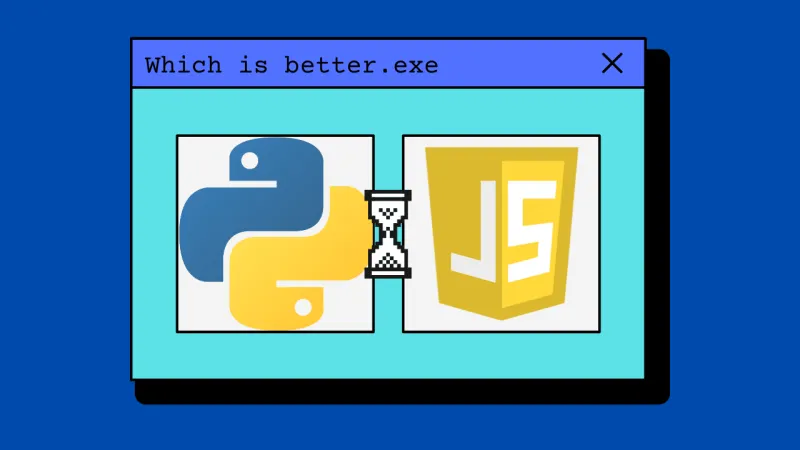Python and R made a name for themselves as top-end competitors in the world of data science for their ability to seamlessly navigate and handle data. But what sets these languages apart from each other?
Python vs R Compared 🔗
Python 🔗
Named after the British comedy group Monty Python, Python is a high-level, procedural, general-purpose programming language designed by Dutch computer scientist Guido van Rossum. Python was released in 1991 with multiparadigm, open-source, and dynamic typed properties, and has since become a key choice for back-end web development, data science, and machine learning.
R 🔗
R, on the other hand, took a more personal touch to naming. Named after its creators, Ross Ihaka and Robert Gentleman, R first appeared in 1993 while Ihaka and Gentleman were at the University of Auckland, as an open-source, multiparadigm, dynamically typed programming language.
R is actually the implementation – or modernized – form of the S programming language, which was developed in 1976 to “turn ideas into software, quickly and safely”. It was developed solely for statistical computing and has become an incredibly popular language for data science.
So, we have one multi-functional language and one specific, now it’s time to see how they compare. First, I’ll lay out how each language works for beginners and experts, then break down salary, performance, which is best for data science, machine learning, and you!
R vs Python: Which is easiest to learn and more versatile? 🔗
Python is praised as a beginner language, but it’s useful for all skill levels.
Python was designed to be simple yet strong, and as a result, it’s easy to read and intuitive. It reads like English and uses indentation to show meaning, rather than brackets, mimicking natural writing.
Python also comes with an overstuffed standard library, perfect for crafting easy code and debugging. Even as you progress on to more advanced techniques, they’re still just as easy to pick up. Python’s biggest advantages are its versatility, how easy it is to learn, and how employable knowing Python makes you.
Python is a general-purpose language, so in theory, you can create anything you want. And this especially works well with experimental fields like machine learning, where you need to craft new programs and prototypes. It can also be used as a scripting language, which automates the execution of tasks, perfect for back-end development.
R differs in its simplicity and versatility.
It’s beginner-friendly… at least at first, but once you start getting into the more advanced territory it gets tricky. However, if you have experience coding then it shouldn’t pose too much of an issue.
R is ideal for creating lightweight statistical models and comes with plenty of ready-to-go features like premade tests and models. R’s real strength though comes from its focus on statistics.
R isn’t as versatile as Python, but every aspect of this language is geared towards statistical programming and making statistical analysis and visualization fluid and painless. If you’re secure in the idea of being a statistician or working primarily with statistics, then it doesn’t get better than this.
Overall, Python is a better beginner and expert language if you want diverse career options and want to add a stable and safe language to your tool belt. However, if you work, or want to work, with statistics, then head straight to R.
R vs Python for Data Science 🔗
Both languages are popular for data science, it just depends on what kind of data science you’re doing.
Python is great for mathematical functions and big data. Along with being a strong language, it has libraries like Numpy for mathematics, Pandas for data structures, Keras for modeling, and Scikit-Learn as the industry-standard library for Python data science projects – as well as many others focusing on data visualizations and data mining.
You can also read our article on Python for data science
It also has a massive thriving and welcoming community, which is perfect as an open-source language since it means endless free resources.
Alternatively, R’s greatness in data science lies with statistical data. It has a set of packages called the Tidyverse, which are powerful but easy-to-learn tools for importing, manipulating, visualizing, and reporting on data.
The real difference for R is it’s a programming language for non-programmers. Think researchers, academics, and anyone using statistics, but isn’t necessarily a “developer”. R gives these users easy access to high-grade data visualization and charts.
R also has the Shiny package for dashboard creations, which allows those with little technical experience to easily craft and publish dashboards to share with colleagues.
Overall, if you have a team of dedicated programmers that will benefit from the use of a multipurpose language like Python, then choose Python. But, if you’re not dedicated to programming, then R is a better choice.
R vs Python Salary 🔗
While the price is right for both R and Python, Python does have the slight upper hand.
Python only continues to grow in popularity and demand from developers and companies alike. So, on top of having an easy entry point and versatile language, with Python you’re set for a busy future.
In the 2020 Stack Overflow Developer Survey, US Python developers reportedly earn $120k a year, and R developers earn $109k. And in the same survey, Python was voted number 1 as the most wanted and third most loved language by developers, while R only came in 14th and 16th place respectively.
While it seems like Python is the obvious winner, I argue this reflects the difference between a general-purpose language and a domain-specific one. R focuses on a very specific niche, therefore, it naturally has a smaller audience, whereas Python is reaching a wider variety of programmers and companies.
That said, Python does offer a more well-rounded choice and better repertoire with developers.
Conclusion: Python is better for higher salaries and is more in-demand by employers.
R vs Python Performance 🔗
Usually, with performance, there’s a clear winner, but things aren’t so clean-cut this time. This is because Python performs a range of functions, while R is primarily kept to data analysis and data visualizations.
Also, neither of these languages specialize in performance-intensive applications and are focused on handling large data sets and CPU-heavy programs. However, in an effort to focus our understanding of performance, we’re going to look at how they perform in machine learning.
Here is an R vs Python benchmark of them running a simple machine learning pipeline, and the results show Python runs 5.8 times faster than R for this use-case.
Python isn’t known in the industry for being a performance-based language, but its simple syntax allows for the smooth interpretation of uncomplicated threads and codes. There are also implementations of Python that support compilation and therefore boost performance, like PyPy, which uses the JIT compiler. However, not all packages work with it.
Along with performing better, Python also codes quicker. Its straightforward syntax allows you to create fast clean applications, without dealing with overcomplicated source code.
R is more complex in that performance is heavily reliant on how you’re using the code. With R, a task can be written in several ways and still work, so you need to make sure you’re writing the most efficient task possible. This negatively affects coding time, plus the fact it takes longer to navigate R packages.
Conclusion: Python’s focus on simplicity helps give it an edge during performance and coding time.
R vs Python for Machine Learning 🔗
All those fabulous libraries that help Python with data science also come in handy for machine learning and deep learning, making it virtually possible to run any machine learning algorithm in Python.
These include Scikit-learn, which is a one-stop-shop library for machine learning by supporting supervised and unsupervised tasks. And then there’s Google’s famed deep learning library TensorFlow for building neural networks.
Python’s simple syntax also works perfectly here, since machine learning is very experimental, and a stable readable language adds consistency to the field. As well as the fact there’s only one way to code a task, so the whole team interacts with the program the same way.
You can use Python for scripting or object-oriented programming, and it’s platform-independent, making it incredibly flexible. It’s also interpreted, so there’s no need to recompile source code, and developers can make changes quickly.
With data science and machine learning being so closely related, you’d think R would work well here too, however, R just doesn’t have the same support. R truly is a statistical tool used by academics, engineers, scientists, and those without any programming background that purely need to explore and experiment with data.
Overall, Python is unmatched when it comes to handling large-scale projects and machine learning.
R vs Python for Back-End Development 🔗
Even though Python has gone on to become the top language for machine learning, it was originally created as a software development language. More specifically a back-end web development language, where the focus is on how business logic interacts with the database.
Python’s platform-independent, scripting, and readable properties make it great for crafting back-end servers and server-side dynamic web pages. Python has a rich ecosystem of libraries and frameworks that give you access to pre-written code you can seamlessly implement, cutting down on coding time.
It’s compatible with web frameworks like Django, Flask, and Bottle, which help with URL routing, HTTP response and request, accessing databases, and security.
The number of resources Python has is endless, and that’s before you even access its massive community full of business-focused and open-source support.
To be frank, R simply isn’t a back-end language. The only aspect that could be used for back-end work is its Shiny package, which can create web apps for web pages, but it by no means develops web pages.
R was developed by statisticians for statisticians to make data modeling and visualizations better. Not to be an easy programming language or to master the programming industry. So, in a sense, it almost feels more like a tool rather than a language – just a very well-paid tool.
Conclusion: Python is the clear winner for back-end development, but also if you want to access this, plus a wide range of other options.
R vs Python: The Final Verdict 🔗
When choosing between R and Python, the main thing you need to focus on is your goal. Because these languages offer similar value, it comes down to your specific wants to figure out which one is best.
Do you want to work in a developer role? Do want flexibility when it comes to career opportunities? Do you prefer modern work environments, like start-ups, and experimental fields like data science? If so, then without a doubt choose Python and take advantage of all the features it has to offer.
However, if you want to strictly study data and access statistical help, have no plans of working as a programmer but need access to programming capabilities, and plan to work – or work – in academia or engineering settings, then it doesn’t get any better than R.
In the end, both languages offer amazing resources, benefits, and careers, but your goals need to align with them to get the most out of either language.
If you’re looking to learn Python, we designed our Learn Python course to teach you the fundamentals and reach an intermediate skill level. From there, you’ll have the tools you need to land an entry-level Python job. If you’ve already got the fundamentals down, we also have a Data Structures and Algorithms course and Data Structures and Algorithms 2 course to finetune your Python skills.
Our courses are fully interactive, where you code the answer to each lesson’s challenge, giving you hands-on experience in real-life mimicking scenarios. Learning by doing is the most effective way to fast-track your learning and get qualified and employed in your dream coding role.



